Don’t call it a comeback.
It appears that drawing is now everywhere. Drawings’ Conclusions just closed at Anyspace, New York; Drawing Codes: Experimental Protocols of Architectural Representation is in the Taubman Gallery at the University of Michigan; The Drawing Show opened recently at the Yale School of Architecture Gallery; Drawbot is at the AA[n+1] Gallery in Paris; and there is the current exhibition at the Austrian Cultural Forum titled The Projective Drawing.1 It might seem obvious that to exhibit architecture is to exhibit drawings, but for the past twenty years, it has been infrequent to focus an exhibition of contemporary architectural work around the question of drawing. The quick reaction would be to attribute this to the pinging pain of nostalgia in the midst of our image-saturated world. But this would be a mistake, for at their best, these shows revolve around not a return, but a provocation concerning how to define drawing and image in contemporary aesthetic discourse.
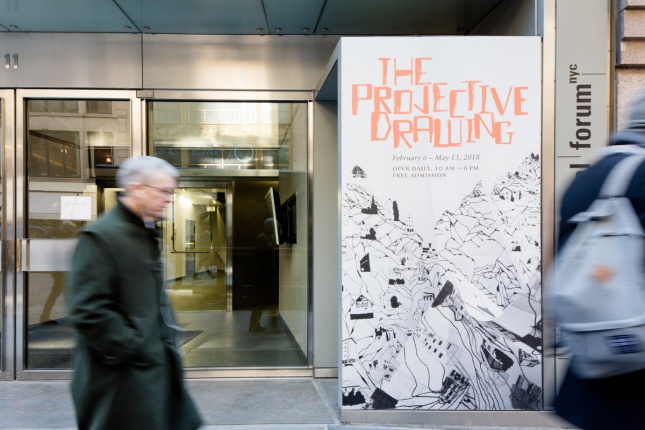
The curator of The Projective Drawing exhibition, Brett Littman, has explicitly tied the show to a collection of essays written by Robin Evans and published posthumously in 1995 as The Projective Cast. An exhibition squarely in the realm of art that is developed from a piece of architectural theory is quite rare, which is what immediately excited me about the prospects of this show. The drawings exhibited here often reference architecture, and several pieces use techniques more commonly associated with architectural drawing, (the axonometric being the prime example), but these pieces are clearly art, not architectural drawings. Specifically, the difference is that none of the drawings in this exhibition work through projection as practiced by architects and explicated in the texts of Robin Evans. This may initially sound like a critique of the premise of the exhibition, but I assure you it is not, for the problem of projection in relation to drawing is what is at stake.
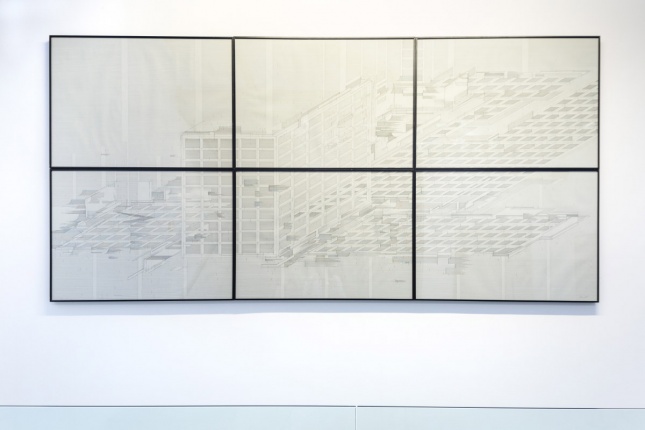
In the essays compiled for Evans’s The Projective Cast and in the influential earlier essay “Translations from Drawing to Building” (1986), Evans observes that a significant amount of architectural representation does not consist of iconic plane geometry or the pictorial under-drawing used to structure composition in painting. Instead, it is focused around translations of formal and spatial notations toward construction. Projective geometry is engaged in order to control these transformations. The shadows cast by projection are controlled distortions, traces registering movements of graphic information, and residues that elude symbolic interpretations associated with the pictorial. For many architects, orthographic projections (which are very different than orthographic drawings), perspectives, or obliques are what differentiate architectural from other types of drawing practices. These are the techniques that discipline an architect toward thinking three-dimensionally through two-dimensions. In other words, projection is the background operating system of architectural drawing.
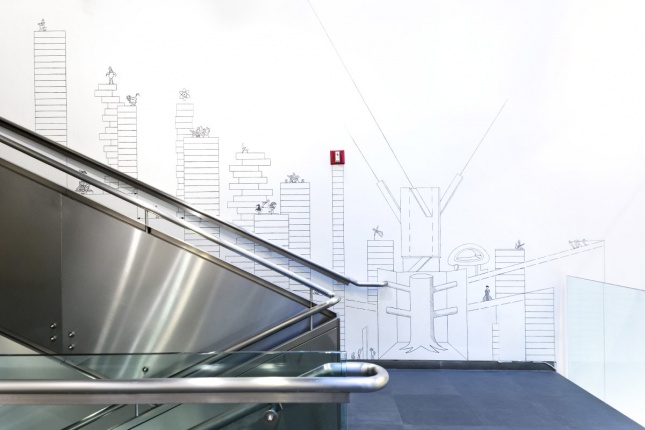
Over the last 25 years, the digital model has replaced the architectural drawing. If drawings are produced from a digital model, they are no longer the graphic traces of constructed projections, they are images, rendered to follow the visual conventions of drawing.2 Although this output may be an image, projective geometry is fundamental for digital modeling software. This is evident not just through the real-time updating of views, or the unfolding/sectioning of surfaces, but also, projection is at the root of calculating texture maps and indices of light reflection; commonly called “rendering.” Evans was prescient about this aspect of projection, for it is much more concerned with the optic than the haptic. Interestingly, architecture has typically considered projection as having more to do with drawing than rendering. The history of drawing is so entwined with projection that the graphic lines constructing projections were literally called “pencils” in early descriptive geometry textbooks. Furthermore, many architects view digital software with suspicion, precisely because of its affiliation with images as opposed to drawings. Evans may not have written much about digital representation per se, but in many ways his arguments accurately articulate the background of contemporary digital modeling software. As it stands, architects today are continuously engaged with the transformations of projective geometry through digital modeling, even if these projections no longer leave a visual residue, and most often operate hidden within the commands of the software. And it is here that we have the problem.
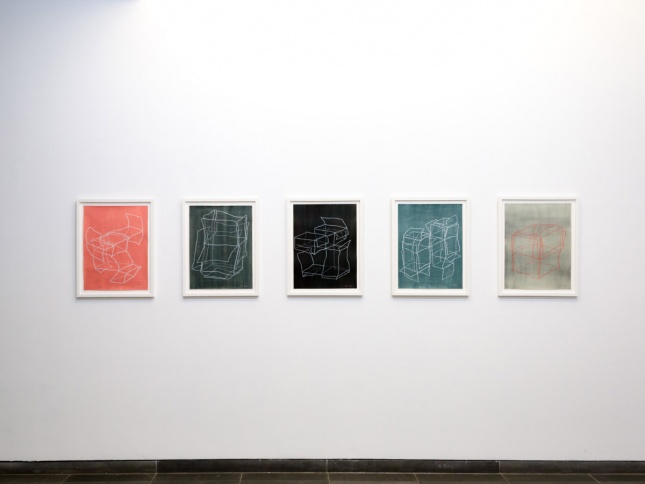
If the visible trace of projection was crucial for defining an architectural drawing, and if digital software removes these traces in the production of images, we are left with a curious predicament. When looking at digitally produced drawings, either we are not looking at architectural drawings or, we are not looking at drawings at all. One of these is a disciplinary problem, the other aesthetic. The digital is not a new paradigm in itself. But, it does require revaluations regarding the conventions of different mediums, and it is in these transformations that we may formulate new sets of concerns.
The Projective Drawing exhibition offers some fascinating insights on this issue for architectural representation. The drawings in this show mix mediums continuously. At the same time, this is not a post-medium mush where drawing is fused with painting, graphic design, architecture, etc. The questions this work raises have more to do with the tensions between abstraction and realism, and the manners through which drawing can question the ways in which we image the world. In a series entitled transmissions: a more radical elsewhere (2005-2012), William Cordova creates mixed media collages of drawings that build worlds suggesting telecommunication transmissions to places “out-of-field”—potentially even out-of-time. Brigitte Mahlknecht has produced a series of drawings of unfolding axonometric boxes titled Fast Architektur (2017), that use wavering stumbling lines ghostly layered to suggest the impossibility of ever folding these objects back up. The large oblique drawing titled Flatlands (corner) (2016) and created by Seher Shah is clearly indebted to the precision of architectural line drawings and the techniques of axonometry. But in this case, the line work shifts over edges that should define corners calling attention to the flickering instability of optical depth. In a series of small-framed untitled pieces, Leopold Strobl draws on top of color manipulated newsprint clips. Into these landscapes and cities he intervenes with dark blank masses. These hover between object-like figures and void-like removals, establishing a tension with the realism of the mechanically reproduced images in the background. In the most provocative instances, the viewer finds their attention drifting into these backgrounds, wondering what world(s) could contain these things.
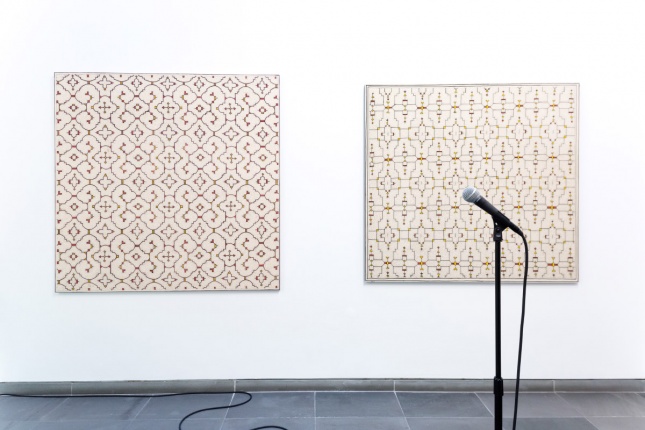
The works in The Projective Drawing are projective as speculations, not as medium-dependent techniques. Architects have placed too much emphasis on drawing versus imaging as a disciplinary conflict. What matters are paradigms, the concepts made intelligible beside (para) aesthetic provocations. The Projective Drawing exhibition is in many ways an exploration of exactly this; the mediums appropriated within the aesthetics of the works provoke allusions that extend outward. These are relations between aesthetics and politics, between what can be seen and said, and what actions we project into the world.
I would much rather have architects arguing about these issues than if their images looked more like drawings or photos.
- Drawings’ Conclusions at Anyspace curated by Jeffrey Kipnis and Andrew Zago brought to New York by Cynthia Davidson; The Drawing Show at the Yale School of Architecture Gallery, originally at A+D Museum Los Angeles curated by Dora Epstein Jones, Drawing Codes curated by Adam Marcus and Andrew Kudless on view at the Taubman Gallery at the University of Michigan, originally at the CCA in San Franciso, Drawbot 2 is on display at the AA[n+1] gallery Paris, France curated by Emmanuelle Chiappone-Piriou and Leslie Ware, and The Projective Drawing at the Austrian Cultural Forum curated by Brett Littman.
- A fascinating discussion of this condition was recently put forward by John May in the article “Everything is Already an Image” published in Log 40 (MIT Press, 2017)











